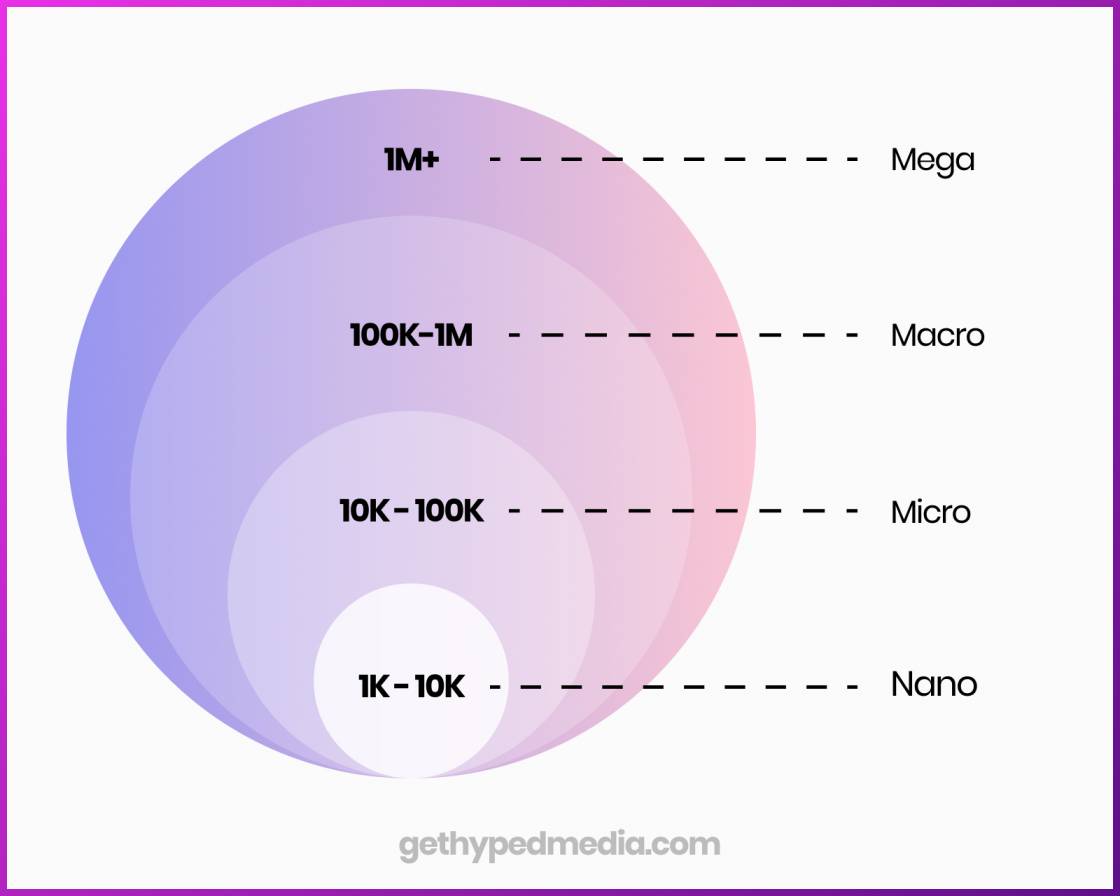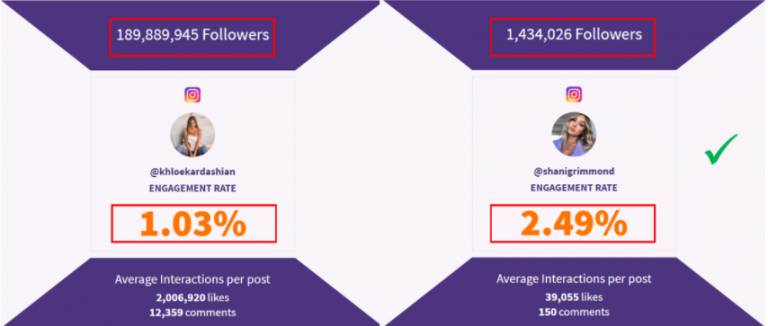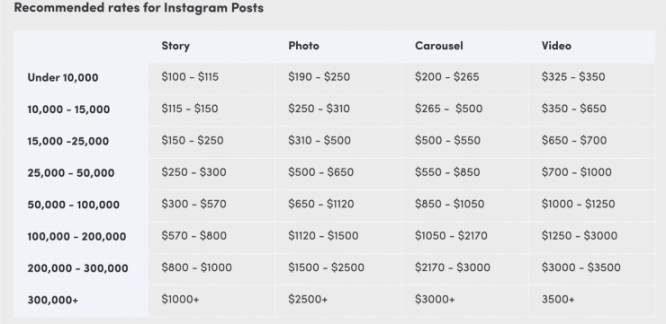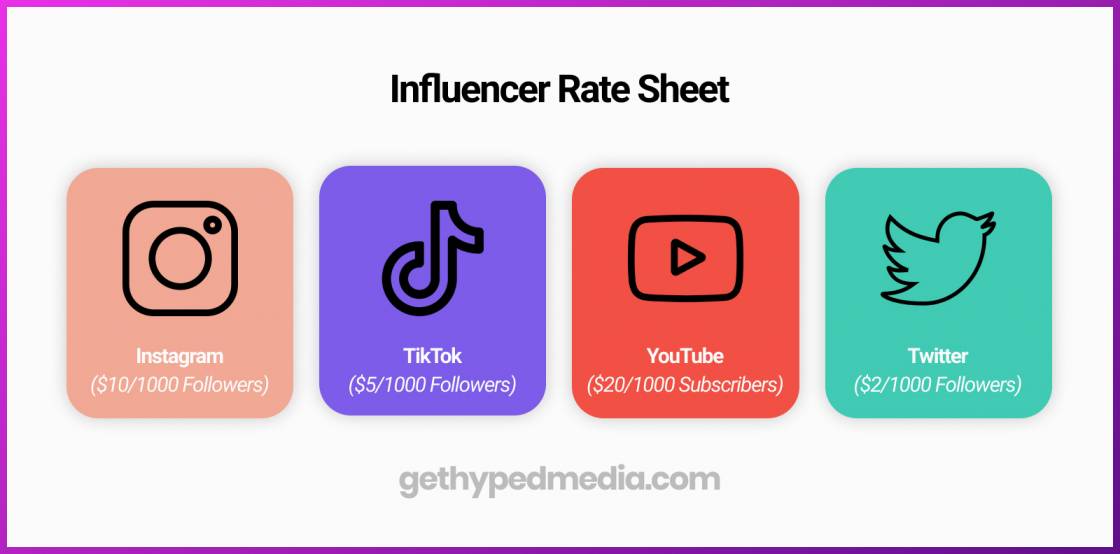Want to find out what a standard influencer rate sheet looks like?
Well, you are up for a surprise.
The fact is that influencer rates vary across social media channels, industries, and even from one influencer to another.
But, there is a method to this madness. There are certain rules that you can follow to calculate standard influencer rates considering only their reach and platform.
Then you can get an even more exact rate by accounting for additional variables like engagement rate, niche and content type. This will help you budget for your next influencer marketing campaign.
In this post, you will learn:
- The standard influencer rate sheet calculations
- Other factors that affect influencer rates
- How to find an influencer within your budget
Ready to get started?
Let’s go.
Table of Contents
What is an Influencer Rate Sheet?
Influencers use rate sheets to provide the details of the fees they charge for different types of brand collaborations and any other services they offer.
An influencer rate sheet is also known as an influencer rate card. It provides the information brands need about an influencer’s services and terms and conditions before they start working together.
A typical influencer rate sheet comprises:
- Professional bio: A brief description of the influencer, including their name, personal interests, and professional background. It also includes an image of the influencer.
- Services offered: A breakdown of the services an influencer offers. This includes any combo deals or packages as well.
- Engagement metrics: Insights on the influencer’s audience demographics, number of followers, website traffic, reach, and engagement rate.
- Pricing structure: Information on the influencer’s pricing model—whether they charge per post, click, subscriber, or view. This section also includes information about payment terms, such as whether they expect upfront or post-delivery payments.
- Terms and conditions: The influencer’s policies on usage rights, content revisions, and approvals. It also provides information on the kind of content the influencer will or will not be willing to create.
- Contact information: The influencer’s mobile number, email address, and other contact information for booking inquiries. Influencers can also include their booking links in this section.
CTA
Skyrocket your business growth and achieve greater heights through influencer marketing
And grow your business!
Standard Influencer Rate Sheet – By Reach and Platform
The standard influencer rates are decided by how many followers an influencer has and their choice of social media platform.
It is usually calculated as the price per thousand followers or subscribers for a single post. According to a WebFX report, the following are the standard influencer rates for the top four social media platforms.
Instagram ($10/1000 Followers)
All prices are updated for 2024 for a single Instagram in-feed post for influencer marketing on Instagram.
- Nano influencers (1K to 10K followers): $10–$100
- Micro-influencers (10K to 100K followers): $100–$1,000
- Macro influencers (100K to 1m followers): $1,000–$10,000
- Mega influencers (1m + followers): $10,000+
An Instagram influencer can charge higher prices if they are very popular or are in a niche with few influencers. Posts can include images, IGTV, Reels and Stories. Content creators usually charge less for an Instagram Story than they do for a post.
For example, if a macro influencer creates content for Instagram Stories, they can charge about $0.06 for each view the story gets.
However, there’s more to it. If the campaign’s goal is sales conversions, they can charge $0.06 plus a commission on every sale they helped make.
There can be other add-on charges based on the number of posts, production expenses, or exclusivity rights.
YouTube ($20/1000 Subscribers)
All prices are for a single video mention or integration for influencer marketing on YouTube. If you’re looking for dedicated videos, expect that they could be twice the rates below or more depending on the length and complexity of the dedicated video.
- Nano-influencers (1K to 10K followers):: $20–$200
- Micro-influencers (10K to 100K followers): $200–$2,000
- Macro-influencers (100K to 1m followers): $2,000–$20,000
- Mega-influencers (1m + followers): $20,000+
While these are the standard average rates, YouTube influencers with over one million subscribers may charge higher. Sometimes, they may charge as much as $50,000 per video.
Some YouTubers set their prices based on the number of views their videos get. This is usually the case if the video content is a sponsored post that shows an unboxing of your product, a try-on-haul, or a product review.
TikTok ($5/1000 Followers)
Untill recently, Instagram used to be the most popular influencer marketing platform. However, recent research shows that TikTok is now used by 69% of brands for running an influencer marketing campaign, while only 47% of brands use Instagram.
All prices are for a single post.
- Nano influencers (1K to 10K followers): $5–$50
- Micro-influencers (10K to 100K followers): $50–$500
- Macro influencers (100K to 1m followers): $500–$5,000
- Mega influencers (1m + followers): $5,000+
These prices are just an estimation. They can be higher if the TikTok influencer has over one million followers.
TikTok is a great platform for reaching a younger audience and sharing short-form video content.
As such, TikTok influencers create short-form content that can easily go viral. This could be short product tutorials, unboxing videos, or entertaining challenges to promote the brands they work with.
The pricing structure for TikTok content could be pay per post, click, or view. There could also be add-on charges if the influencer helps the brand get more sales conversions.
Facebook ($25/1000 Followers)
Despite the rise of new platforms, Facebook remains relevant. According to Statista, it remains the world’s most popular social network worldwide, with over 3 billion monthly active users.
Here’s an overview of what Facebook influencers charge on average.
- Nano-influencers (1K to 10K followers): $25–$250
- Micro-influencers (10K to 100K followers): $250–$2,500
- Macro-influencers (100K to 1m followers): $2,500–$25,000
- Mega-influencers (1m + followers): $25,000+
Facebook influencers with over a million followers tend to deviate from these average prices. They may charge more because they have the numbers for it.
Influencer prices also depend on the type of content they create. For instance, influencers often charge less to post content on Facebook Stories than on the main feed. This is because Facebook Stories only last 24 hours and are usually shorter than posts.
Facebook influencers may also charge additional fees for posting content with shoppable links rather than just brand mentions.
Remember, this influencer rate sheet is just a starting point for calculating ball-park prices and there are several other factors that will impact an influencer’s rates.Want to learn more about what these other factors are that affect influencer rates?
Find out in the next section.
CTA
Dive deeper with Get Hyped’s expert influencer strategies and watch your brand soar to new heights. Don’t just follow the trends—set them.
And unlock your brand’s full potential!
Factors That Affect Influencer Rates
There are several factors that can influence an influencer rate sheet, not just the follower count. Though the standard influencer rate sheets don’t reflect these, you should keep these factors in mind to offer the right compensation to influencers.
If you want an easy way to calculate influencer rates, incorporating various factors, then use our Influencer Rate Calculator tool. It will quickly give you an estimate of how much you should pay influencers based on various factors.
Still, you should be aware of the various factors that affect influencer prices.
Ready to learn what these factors are?
Here you go.
Reach
The primary factor that determines influencer rates is an influencer’s reach. The more followers an influencer has, the more their rate will be.
There are five types of influencers based on reach:
- Nano Influencers: <10K followers
- Micro-Influencers: 10K–100K followers
- Macro Influencers: 100K-1M followers
- Mega Influencers: 1M+ followers

You might find slight variations of this categorization, but this is the most popular version.
Platform
Platform plays a major role in influencing an influencer’s rate sheet. The same influencer will charge a different rate for Instagram than they do for YouTube.
We discussed these variations in the influencer pricing, by the platform, in detail at the beginning of the post.
Niche
As a general rule, the more influencers there are in a niche, the more competitive their prices will be. So, if you’re looking for a beauty influencer, for example, you will get plenty of options and enough negotiation power.
However, if you are looking for an influencer in a very specific niche, such as cyber security, then they can charge higher rates, within the limits of reason, of course.
Engagement
An influencer’s rate also depends on the rate of engagement that they get on their posts. Engagement is calculated based on the number of views, likes, shares, comments, etc.
If an influencer has a wide reach but doesn’t get much engagement, then it’s not worth collaborating with them. Instead, an influencer with a modest reach and high engagement will drive better results because the point of influencer marketing is to grow affinity around your brand. Brand affinity strengthens when social media users are having positive conversations about your brand and are building your online community.

Information Source: Phlanx
While you may get mesmerized by the big numbers that mega and celebrity influencers can provide, you should also remember that working with a smaller influencer is much more affordable and can also be more effective. You can get a higher ROI from a comparatively smaller influencer with a high engagement rate.
Type of Content
We all agree that different types of content can take different amounts of time and effort to create.
Then why should all those content types cost the same amount?
This is why influencer rates depend on the type of content that influencers are expected to create. In general, the more time, effort, and resources that are required, the higher the influencer rate will be for that type of content. This is why partnering with influencers is so great – influencers are the creative, talent, production, and editing teams all wrapped into one affordable price with the convenience of one-stop shopping.
Content Ownership
Content ownership rights are the contractual terms that specify who owns the intellectual property of the content created by the influencer. Whoever has these rights can use or edit the content according to their preferences.
By default, the influencer holds ownership rights to the content they create. However, if you want to repurpose influencer content (UGC) to places like your brand’s social media and website, then you want to negotiate content ownership rights into your agreement with the influencer.
That usually costs extra, especially with macro-influencers and larger. You will want to include content licensing details when you formalize your influencer contracts.
Exclusivity
If you want the influencer to agree to exclusivity, to not work with any competitors for a period of time before or after the posting for your brand, then influencers typically charge extra depending on the total length of exclusivity.
Influencers will usually include exclusivity for free for periods of anywhere from 24 hours to 30 days depending on the size and popularity of the influencer.
For periods of exclusivity beyond 30 days, expect most influencers to increase their rate to account for other partnerships that they may have to turn down.
How to Find an Influencer Within Your Budget
Finding the right influencer who aligns with your brand and fits your budget requires careful consideration of certain factors.
Some of these factors include the type and duration of the campaign, number of followers, engagement rate, niche, quality of content, and platform choice. Let’s discuss them below.
- Number of followers: As mentioned, the price an influencer charges depends on the number of followers they have. If you have a tight budget, consider looking for nano or micro-influencers within your niche who have good engagement rates.
- Platform: The content creation process differs for different social media platforms. As such, influencers charge different prices depending on the platform. For instance, content creators on Instagram typically charge higher than those on TikTok.
- Quality of content: Influencers who use high-quality equipment and invest significant time and effort into content creation often charge higher fees. So if you’re looking for an influencer who creates high quality content, you will have to pay more. However, always check the quality of an influencer’s content to see if it offers the same value as their price.
- Niche: Influencers in certain niches often charge more than those in others. If you’re interested in working with influencers in high-paying niches, such as travel content, beauty, fashion, and lifestyle, you will likely pay more.
- Type of campaign: Different types of posts incur different production costs. For example, the time and effort it takes to create Instagram stories is usually less than what it takes to create reels. Therefore, the former will typically cost less.
While you can source influencers yourself, the process can quickly become long and overwhelming.
To make it easier, you can hire experienced influencer marketing agencies like Get Hyped. Its team of experts can help you find influencers who fall within your budget and align with your brand message.
Why Should You Create an Influencer Rate Sheet?
An influencer rate sheet is beneficial for both brands and influencers. It makes influencers appear more professional and helps brands plan their campaigns more effectively.
Here are the benefits of creating an influencer rate sheet.
- Fosters Transparency: An influencer rate sheet is an official document that provides clear, up-front information about an influencer’s pricing. This removes ambiguity and helps influencers build trust with their potential clients right from the start.
- Enhances Professionalism: Having a rate sheet makes an influencer appear more professional. An expertly compiled influencer rate sheet gives brands the impression that the influencer knows what they are doing. It also implies that the influencer will take any future collaborations seriously.
- Streamlines Negotiations: An influencer rate sheet serves as a starting point for negotiations. Instead of negotiating blindly, brands can use the rate sheet to benchmark the influencer’s prices against industry standards. This allows them to negotiate a price that works for both parties.
- Streamlines Communications: An influencer rate sheet streamlines communication between brands and influencers and helps avoid misunderstandings. It reduces the need for going back and forth over emails, DMs, or phone calls to discuss pricing and terms and conditions. Instead, brands can refer to the rate sheet, which has all the information they need before working with the influencer.
- Provides Value: An influencer can use a rate sheet to highlight their unique selling points and value propositions. Besides stating their prices, they can also include their professional background and past achievements in the rate sheet. This allows them to show what sets them apart from the competition and why brands should work with them.
- Enhances Consistency: An influencer rate sheet helps influencers maintain consistent rates and avoid arbitrary pricing. It allows them to compare their rates with industry standards, ensuring they remain competitive and fair.
FAQs
1. What is an influencer rate sheet?
An influencer rate sheet is used to determine the pricing for the services offered by an influencer for a business. Influencer rate sheets are also known as media kits, rate cards, or simply influencer rates.
Influencers can use a rate sheet or rate card to offer specific services and packages to brands.
It’s common that smaller influencers like nano and micro influencers don’t have a formal rate sheet. But usually macro-influencers and larger are more experienced with partnerships and have a formal rate sheet available to share with brands.
2. How is the influencer rate calculated?
Influencer rate is primarily calculated based on the reach and engagement of an influencer. However, certain other factors like the choice of platform, type of content, niche, etc. can also play a role in determining the influencer rate.
3. How do you price yourself as an influencer?
As an influencer, your first concern should be the amount of time, effort, and resources that will be required for any particular collaboration. You want to make sure that you get fair compensation for your services.
However, that’s just the minimum rate that you can get. You should also check how much you’re worth based on your reach, engagement, and the market rate of what other similar influencers are charging.
Your influencer rate should be somewhere between the minimum requirement and the best rate that you can get. The goal is to arrive at a rate that is fair for both the influencer and the brand so that both parties are happy and excited about the partnership so that it can continue long term.
Start small and if you get too many partnerships, increase your rates until your number of partnerships comes down to a level that you’re comfortable with.
4. What are the factors that affect influencer rates?
Here are the key factors that can affect influencer rate sheets:
- Reach – the number of followers an influencer has
- Platform – the platform or platforms on which the influencer is active
- Niche – whether the influencer is from a popular or a specialized niche
- Engagement – how much engagement does the influencer get on their posts
- Type of content – how much time, effort, and resources will be needed to create that content
- Content ownership – will the brand be allowed to reuse the content
- Exclusivity – extra charges for the influencer signing a non-compete agreement
- Market demand – holiday seasons cause influencer rates to temporarily increase
5. What is the formula for calculating influencer rate?
As a general rule, brands offer up to $25 per thousand followers or subscribers per post, depending on the social media channel. Here is a standard influencer rate sheet calculation to help you out.
| Platform | Price Per Post |
| $20/1000 Followers | |
| YouTube | $25/1000 Subscribers |
| TikTok | $5/1000 Followers |
However, this is just a generic way of calculating and there are many other factors that affect the influencers rates. Use this as a reference, but do account for the other factors that affect influencer pricing to come at the right price.
Final Thoughts
Running a successful influencer marketing campaign doesn’t have to be costly. You can easily find influencers yourself within your budget and leverage their services to achieve your influencer marketing goals. The key is to understand how to calculate influencer pricing and offer fair compensation for their services.
Use the standard influencer rate sheet above to get a rough idea of how much you should pay an influencer for their services. Then, look at the other factors and calculate any extras specific to the influencer to come to a final price.
One piece of advice, though, is to be flexible with influencer rates when negotiating terms. Don’t stick to one number. Keep some wiggle room when you negotiate with influencers. The goal is to come to an agreed upon rate that both your brand and the influencer are happy with. This will result in the influencer being excited to create high-performing content for your brand, and you’ll be happy with the results.
If you need help finding and negotiating with the right influencers for your brand, get in touch with our team and we’ll help you enter into influencer partnerships at a market price that leads to success!





